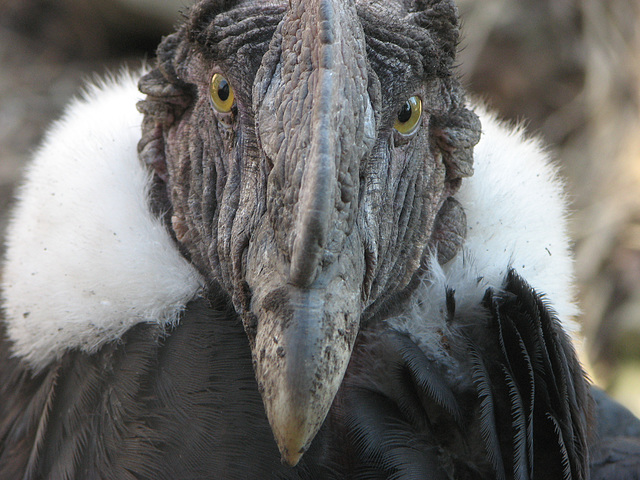Mt. Lorette area 4
Bow Valley Provincial Park
Close encounter
Another one bites the dust
My little buddy
Magnificence
Orange 4
Elbow Falls
Just what the doctor ordered
Orange 5
Vertigo
Five
One
Blue beauty
Oh, my hair!
Flicker Beauty
This gentle creature
I don't WANT my picture taken!
Deep in thought
Down by the river
In the blink of an eye
There's no time like snow time
Get out of my face!
A good old shake
Bow Valley Provincial Park
Bow Valley Provincial Park
Deep glow
Snowy Owl
Gentleness and grace
Colours of spring
A change from orange
Thank you, spring
Alone
Lipstick smudges
It's me again
Enjoying the sun
Glorious spring
Illusions of warmth
Thank goodness for Tulips!
Spring glow
Pink
Simplicity
Frozen innocence
Takes my breath away
Rose
See also...
Keywords
Authorizations, license
-
Visible by: Everyone -
All rights reserved
-
118 visits
Winner of the staring contest


This is Lorenzo, a male Andean Condor, one of a pair brought to the Calgary Zoo about two weeks ago. Males have browny/yellow eyes, and females have red eyes.
"The Andean Condor, Argentinean Condor, Bolivian Condor, Chilean Condor, Colombian Condor, Ecuadorian Condor or Peruvian Condor (Vultur gryphus), is a species of bird in one of the vulture families. It is in many regards the largest flying land bird in the Western Hemisphere and is the heaviest, but not the lengthiest, member of the order Ciconiiformes.
This condor inhabits the Andes mountains. Although it is primarily a scavenger, feeding on carrion, this species belongs to the New World vulture family Cathartidae, related to storks and not closely related to Old World vultures, which are in the family Accipitridae along with hawks, eagles and kites.
The adult plumage is of a uniform black, with the exception of a frill of white feathers nearly surrounding the base of the neck and, especially in the male, large patches or bands of white on the wings which do not appear until the completion of the first moulting. As an adaptation for hygiene, the head and neck have few feathers, exposing the skin to the sterilizing effects of dehydration and ultraviolet light at high altitudes, and are meticulously kept clean by the bird. The head is much flattened above. In the male it is crowned with a caruncle or comb, while the skin of the neck in the male lies in folds, forming a wattle. The skin of the head and neck is capable of flushing noticeably in response to emotional state, which serves to communicate between individuals.
The female, contrary to the usual rule among birds of prey, is smaller than the male.
Wild condors inhabit large territories, often traveling 250 km (150 miles) a day in search of carrion. They prefer large carcasses such as deer or cattle which they spot by looking for other scavengers, who cannot rip through the tougher hides of these larger animals with the efficiency of the larger condor. In the wild they are intermittent eaters, often going for a few days without eating, then gorging themselves on several pounds at once, sometimes to the point of being unable to lift off the ground." Taken from Wikipedia.
"The Andean Condor, Argentinean Condor, Bolivian Condor, Chilean Condor, Colombian Condor, Ecuadorian Condor or Peruvian Condor (Vultur gryphus), is a species of bird in one of the vulture families. It is in many regards the largest flying land bird in the Western Hemisphere and is the heaviest, but not the lengthiest, member of the order Ciconiiformes.
This condor inhabits the Andes mountains. Although it is primarily a scavenger, feeding on carrion, this species belongs to the New World vulture family Cathartidae, related to storks and not closely related to Old World vultures, which are in the family Accipitridae along with hawks, eagles and kites.
The adult plumage is of a uniform black, with the exception of a frill of white feathers nearly surrounding the base of the neck and, especially in the male, large patches or bands of white on the wings which do not appear until the completion of the first moulting. As an adaptation for hygiene, the head and neck have few feathers, exposing the skin to the sterilizing effects of dehydration and ultraviolet light at high altitudes, and are meticulously kept clean by the bird. The head is much flattened above. In the male it is crowned with a caruncle or comb, while the skin of the neck in the male lies in folds, forming a wattle. The skin of the head and neck is capable of flushing noticeably in response to emotional state, which serves to communicate between individuals.
The female, contrary to the usual rule among birds of prey, is smaller than the male.
Wild condors inhabit large territories, often traveling 250 km (150 miles) a day in search of carrion. They prefer large carcasses such as deer or cattle which they spot by looking for other scavengers, who cannot rip through the tougher hides of these larger animals with the efficiency of the larger condor. In the wild they are intermittent eaters, often going for a few days without eating, then gorging themselves on several pounds at once, sometimes to the point of being unable to lift off the ground." Taken from Wikipedia.
- Keyboard shortcuts:
Jump to top
RSS feed- Latest comments - Subscribe to the comment feeds of this photo
- ipernity © 2007-2024
- Help & Contact
|
Club news
|
About ipernity
|
History |
ipernity Club & Prices |
Guide of good conduct
Donate | Group guidelines | Privacy policy | Terms of use | Statutes | In memoria -
Facebook
Twitter

Sign-in to write a comment.